Starch and the control of kernel number in maize at low water potentials
- PMID: 10482657
- PMCID: PMC59374
- DOI: 10.1104/pp.121.1.25
Starch and the control of kernel number in maize at low water potentials
Abstract
After reproduction is initiated in plants, subsequent reproductive development is sometimes interrupted, which decreases the final number of seeds and fruits. We subjected maize (Zea mays L.) to low water potentials (psi(w)) that frequently cause this kind of failure. We observed metabolite pools and enzyme activities in the developing ovaries while we manipulated the sugar stream by feeding sucrose (Suc) to the stems. Low psi(w) imposed for 5 d around pollination allowed embryos to form, but abortion occurred and kernel number decreased markedly. The ovary contained starch that nearly disappeared during this abortion. Analyses showed that all of the intermediates in starch synthesis were depleted. However, when labeled Suc was fed to the stems, label arrived at the ovaries. Solute accumulated and caused osmotic adjustment. Suc accumulated, but other intermediates did not, showing that a partial block in starch synthesis occurred at the first step in Suc utilization. This step was mediated by invertase, which had low activity. Because of the block, Suc feeding only partially prevented starch disappearance and abortion. These results indicate that young embryos abort when the sugar stream is interrupted sufficiently to deplete starch during early ovary development, and this abortion results in a loss of mature seeds and fruits. At low psi(w), maintaining the sugar stream partially prevented the abortion, but invertase regulated the synthesis of ovary starch and partially prevented full recovery.
Figures
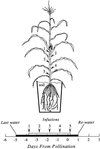




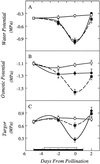
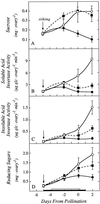
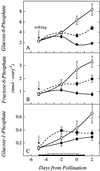
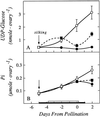
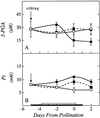


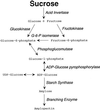
Similar articles
-
Glucose localization in maize ovaries when kernel number decreases at low water potential and sucrose is fed to the stems.Ann Bot. 2004 Jul;94(1):75-86. doi: 10.1093/aob/mch123. Epub 2004 May 24. Ann Bot. 2004. PMID: 15159218 Free PMC article.
-
Sugar-responsive gene expression, invertase activity, and senescence in aborting maize ovaries at low water potentials.Ann Bot. 2004 Nov;94(5):675-89. doi: 10.1093/aob/mch193. Epub 2004 Sep 8. Ann Bot. 2004. PMID: 15355866 Free PMC article.
-
Grain yields with limited water.J Exp Bot. 2004 Nov;55(407):2385-94. doi: 10.1093/jxb/erh219. Epub 2004 Jul 30. J Exp Bot. 2004. PMID: 15286147 Review.
-
Soluble invertase expression is an early target of drought stress during the critical, abortion-sensitive phase of young ovary development in maize.Plant Physiol. 2002 Oct;130(2):591-604. doi: 10.1104/pp.005637. Plant Physiol. 2002. PMID: 12376627 Free PMC article.
-
Molecular and biochemical mechanisms in maize endosperm development: the role of pyruvate-Pi-dikinase and Opaque-2 in the control of C/N ratio.C R Biol. 2008 Oct;331(10):772-9. doi: 10.1016/j.crvi.2008.07.019. Epub 2008 Sep 4. C R Biol. 2008. PMID: 18926491 Review.
Cited by
-
Expression of CsSEF1 gene encoding putative CCCH zinc finger protein is induced by defoliation and prolonged darkness in cucumber fruit.Planta. 2013 Mar;237(3):681-91. doi: 10.1007/s00425-012-1787-7. Epub 2012 Oct 25. Planta. 2013. PMID: 23096488
-
Glucose localization in maize ovaries when kernel number decreases at low water potential and sucrose is fed to the stems.Ann Bot. 2004 Jul;94(1):75-86. doi: 10.1093/aob/mch123. Epub 2004 May 24. Ann Bot. 2004. PMID: 15159218 Free PMC article.
-
Identification of Drought Tolerant Mechanisms in Maize Seedlings Based on Transcriptome Analysis of Recombination Inbred Lines.Front Plant Sci. 2016 Jul 26;7:1080. doi: 10.3389/fpls.2016.01080. eCollection 2016. Front Plant Sci. 2016. PMID: 27507977 Free PMC article.
-
Differential response of wild and cultivated wheats to water deficits during grain development: changes in soluble carbohydrates and invertases.Physiol Mol Biol Plants. 2015 Apr;21(2):169-77. doi: 10.1007/s12298-015-0283-5. Epub 2015 Mar 14. Physiol Mol Biol Plants. 2015. PMID: 25964711 Free PMC article.
-
Differences in membrane selectivity drive phloem transport to the apoplast from which maize florets develop.Ann Bot. 2013 Apr;111(4):551-62. doi: 10.1093/aob/mct012. Epub 2013 Feb 6. Ann Bot. 2013. PMID: 23388879 Free PMC article.
References
-
- ap Rees T. Sucrose metabolism. In: Lewis DH, editor. Storage Carbohydrates in Vascular Plants. London: Cambridge University Press; 1984. pp. 53–73.
-
- Bassetti P, Westgate M. Water deficit affects receptivity of maize silks. Crop Sci. 1993;33:279–282.
-
- Boyer JS. Measuring the Water Status of Plants and Soils. San Diego: Academic Press; 1995.
-
- Boyle MG, Boyer JS, Morgan PW. Stem infusion of maize plants. Crop Sci. 1991a;31:1241–1245.
-
- Boyle MG, Boyer JS, Morgan PW. Stem infusion of liquid culture medium prevents reproductive failure of maize at low water potentials. Crop Sci. 1991b;31:1246–1252.
Publication types
MeSH terms
Substances
LinkOut - more resources
Full Text Sources
Other Literature Sources

